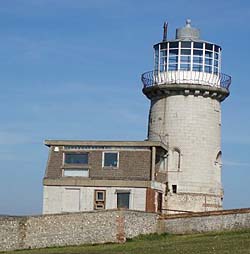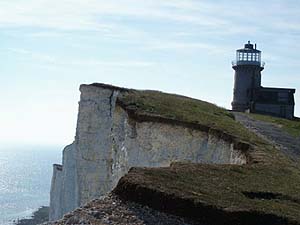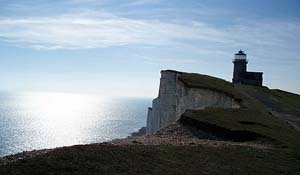
Belle Tout: The Little Lighthouse That Moved
by Elizabeth Wright
 How do you stop an 850-ton lighthouse from toppling over the edge of crumbling cliffs and falling into the sea below? Simple -- you lift it up on runners and drag it slowly back some fifty metres onto safer ground. This is exactly what happened in 1999 to Belle Tout lighthouse, situated on the top of famous Beachy Head cliffs in East Sussex, England. This quaint historic building, just 15m high and being used as a family home, was perilously near the eroding cliff edge. In 1834 it was situated some forty metres away from the edge, but now, one more rock fall and the lighthouse would be a heap of rubble on the beach below.
How do you stop an 850-ton lighthouse from toppling over the edge of crumbling cliffs and falling into the sea below? Simple -- you lift it up on runners and drag it slowly back some fifty metres onto safer ground. This is exactly what happened in 1999 to Belle Tout lighthouse, situated on the top of famous Beachy Head cliffs in East Sussex, England. This quaint historic building, just 15m high and being used as a family home, was perilously near the eroding cliff edge. In 1834 it was situated some forty metres away from the edge, but now, one more rock fall and the lighthouse would be a heap of rubble on the beach below.
But for 172 years Belle Tout has proved itself a survivor, having been built and abandoned, shot at and shattered. Its present owners, Mark and Louise Roberts, were not going to give up without a fight.
The seas around Beachy Head were known as the "Mariners' Graveyard," full of rocky outcrops below the surface, causing many ships to founder. Parson Jonathan Darby (1667-1726), rector of East Dean, became so concerned by the number of shipwrecks and resultant loss of life that, single-handedly, working with chisel, pick and axe and often wearing his familiar beaver skin hat, he set about enlarging an old smuggler's cave in the cliffs. Here, on stormy nights, he hung out lanterns to warn passing ships of the dangers.
After his death in October 1726, the abandoned cavern was once again taken over by smugglers and little appeared to have been done to prevent further shipwrecks. That was until February 1822, when The Thames, an East Indiaman, was beached after hitting a rock off Beachy Head. A concerned Captain of the Royal Navy, who himself had narrowly escaped a similar disaster, vigorously petitioned Trinity House, an association concerned with lighthouse erection and maintenance, to take some action.
John Fuller (1757-1834), a wealthy Member of Parliament for Sussex, exerted his influence to get a lighthouse built on top of the cliffs. The first was no more than a temporary experimental wooden structure, which became operational on the 1st October 1828.
 The building of a proper lighthouse, Belle Tout, started in 1829 to the design of W. Hallett and J. Walker, using huge blocks of Aberdeen granite that were hauled over the down land by teams of Sussex oxen. Its 30 oil lamps, each housed in separate reflectors fixed to a platform that revolved every two minutes, were first lit on October 11th 1834. They threw out a 22,000 candle-power light visible 23 miles out to sea, using 2 gallons of oil per hour. But one important factor had been overlooked in the choice of site for Belle Tout. Sea mists often hugged the cliff tops, obscuring the light. The shipwrecks continued, so in July 1899 work began on the erection of the present Beachy Head lighthouse at the foot of the cliffs. On October 2nd 1902, Belle Tout was decommissioned and eventually sold off as "a small, substantial 3-storey building."
The building of a proper lighthouse, Belle Tout, started in 1829 to the design of W. Hallett and J. Walker, using huge blocks of Aberdeen granite that were hauled over the down land by teams of Sussex oxen. Its 30 oil lamps, each housed in separate reflectors fixed to a platform that revolved every two minutes, were first lit on October 11th 1834. They threw out a 22,000 candle-power light visible 23 miles out to sea, using 2 gallons of oil per hour. But one important factor had been overlooked in the choice of site for Belle Tout. Sea mists often hugged the cliff tops, obscuring the light. The shipwrecks continued, so in July 1899 work began on the erection of the present Beachy Head lighthouse at the foot of the cliffs. On October 2nd 1902, Belle Tout was decommissioned and eventually sold off as "a small, substantial 3-storey building."
In 1923 it was purchased for £1,500 by distinguished neurologist Sir James Purves-Stewart, K.C.M.G., C.B., M.D., who constructed an access road, installed an electric generator and added an extension to the building, turning it into a unique family home.
However, in his book Sands of Time, Sir James wrote, "Soon after taking possession we read a warning article in the local press stating that owing to coastal erosion, grave fears were entertained for the safety of the lighthouse. We decided to secure expert advice. A professor of geology came down from London and, after examining the position, informed us that coastal erosion was undoubtedly going on at a steady rate, and that at the end of six hundred years our tower would find itself at the very edge of the cliff." This deduction appears to have been partly based on measurements showing Belle Tout to be 34m from the cliff edge in 1835 and 30m in 1890.
In 1935 King George V and Queen Mary visited the lighthouse whilst His Majesty was convalescing in nearby Eastbourne. Sir James recounted that they were delightful visitors and easy to entertain. He is quoted as saying, "My wife conducted Queen Mary all over our home, displaying our modest family treasurers. Meanwhile King George entrusted himself to me as a separate guide and took a keen sailor's interest in the various gadgets that had been fitted up. When we came to the foot of the spiral staircase leading to the lantern room, Queen Mary was already aloft, enjoying the stunning view. She called down to him, 'George, don't come up here, it's far too steep for you.' To which his majesty replied, 'Dammit, I'm coming.'"
During the Second World War Belle Tout was left empty, its owners having been evacuated from this vulnerable part of the English coast. By 1942 a firing range had been constructed some 200 yards east of the lighthouse. The Canadian troops, blasting away with everything from light howitzers to cannons, used old cars as targets, but managed to hit Belle Tout several times. By 1943, daylight could be seen through the shattered 6-foot-thick walls.
In 1948 Sir James, having received £5000 war compensation, offered the lighthouse to Eastbourne Borough Council. A councillor had suggested that, for an estimated cost of £10,000 for purchase and repair, there might be the possibility of turning Belle Tout into a tourist attraction, but with heavy expenses and little prospect of an immediate financial return this idea was dropped.
However, as a valued historical building, Belle Tout was eventually taken over by the Council anyway, and in 1956, it was leased out to Dr. Edward Revill Cullinan, who embarked on a rebuilding programme to the domestic part, adding a septic tank, mains electricity and water.
In 1962 the lease of Belle Tout was sold on for £15,000, and changed hands as a private dwelling a number of times. The BBC purchased it in 1986 for a rumoured £250,000 to use as a backdrop for a TV film The Life and Loves of a She-Devil, by author Fay Weldon. They added a temporary stage set on the seaward side and a fake lantern, and constructed tiered gardens, sun terraces and a patio. When all the filming was complete Belle Tout was up for sale again, and bought by businessman Paul Foulkes and his wife Shirley, who continued with the restoration, sympathetically keeping to the unique maritime features of the lighthouse. But as much as they loved the building, it eventually proved to be too far away from their home to be an ongoing weekend retreat. So, in 1995, the lighthouse went up for sale again, this time for £350,000.
Bought by Mark and Louise Roberts in 1996, because "we fell in love with it," it soon became evident, that, after a number of substantial cliff falls nearby, Belle Tout was soon going to end up on the beach 285 feet below. Ambitious plans to do the almost impossible and move the whole lighthouse back some 50 metres, were revealed by the Roberts in 1997. The scheme, carried out by the Abbey Pynford company, involved excavating the ground around the building, putting up beams to support each wall, raising the lighthouse two feet in the air with hydraulic jacks, putting in sliding tracks and lowering the whole 850 tons onto grease skates.
 The South Downs Lighthouse Trust charity was set up to raise the necessary £250,000 for the rescue package. Every contributor to the moving process would get an entry ticket to watch this piece of history in action.
The South Downs Lighthouse Trust charity was set up to raise the necessary £250,000 for the rescue package. Every contributor to the moving process would get an entry ticket to watch this piece of history in action.
Further massive cliff falls and the discovery of unexploded world war two bombs on the beach provoked many worries for the Roberts, who began to fear their treasured listed building would never be moved in time. Their patio was now only three metres from the edge. Mark Roberts told the local press, "I couldn't believe it when the Coastguards said there might have to be a controlled explosion. I just thought, I don't need this. It would be devastating to lose this building."
But by March 17th 1999, after a year of planning, everything appeared ready for Belle Tout's monumental move. In bright sunshine hundreds of media from all around the world watched as Joy Cullinan, who had once lived in Belle Tout, switched on the hydraulic pump at 9.25 am and the whole operation began.
At a painstakingly slow pace -- just two feet in the first three hours -- the lighthouse was moved 28 feet in the first day, every millimetre controlled by computer. So procedures would not be hampered by further cliff falls, no heavy digging machinery was used on the site and all the chalk from the foundations was taken out on wheelbarrows. By the evening of Thursday, March 18th, Belle Tout reached its final position. Louise Roberts is quoted as saying, "We need a long ladder to reach our kitchen door now. But the magnificient views we had are even better now. And all our glass bottles are still perfectly in place!" <
Having originally leased Belle Tout from Eastbourne Borough Council, after three years Louise Roberts was legally entitled to buy the freehold for £900. Today, this little lighthouse still stands proudly on the top of the cliffs, admired by thousands of visitors and walkers on the South Downs Way. Its only other neighbours are rabbits and sheep, and according to local legend, the odd ghost or two. Belle Tout looks good for another 170 years. [Editor's Note: In 2007, Belle Tout was once again being offered for sale.]